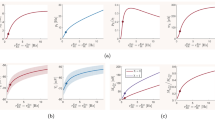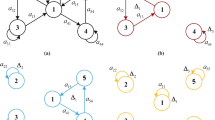Abstract
Several mathematical models, such as Hodgkin–Huxley, FitzHugh–Nagumo, Morris–Lecar, Hindmarsh–Rose, and Leech, have been proposed to explain neural behaviors. Changing the parameters of neural models reveals the various neural dynamics. To make these models as realistic as possible, they should be studied in the networks, where there are interactions between the neurons. Hence, investigating neural models in the networks can be helpful. This study examines the attention-deficit disorder model's bifurcation points in both regular and irregular networks. The networks are analyzed in two cases. In the first case, networks are studied where perturbations enter one node. Calculating the recovery time of the disturbed neuron can investigate the bifurcation points. Results show that recovery time reveals the dynamical variation of the disturbed node. The second case examines networks with different coupling strengths and nodes' degrees. Results indicate that as coupling strengths and nodes' degree increase, bifurcations occur in the smaller parameters in the period-doubling route to chaos. A general trend cannot be seen in the inverse route of period doubling.
































Similar content being viewed by others
Data availability statement
This manuscript has associated data in a data repository. [Authors’ comment: Data generated during the current study will be made available at reasonable request.]
References
Z. Hou, J. Ma, X. Zhan, L. Yang, Y. Jia, Estimate the electrical activity in a neuron under depolarization field. Chaos Solitons Fractals 142, 110522 (2021)
A.L. Hodgkin, A.F. Huxley, The dual effect of membrane potential on sodium conductance in the giant axon of Loligo. J. Physiol. 116, 497 (1952)
R. FitzHugh, Impulses and physiological states in theoretical models of nerve membrane. Biophys. J. 1, 445–466 (1961)
I. Hussain, S. Jafari, D. Ghosh, M. Perc, Synchronization and chimeras in a network of photosensitive FitzHugh–Nagumo neurons. Nonlinear Dyn. 104, 2711–2721 (2021)
C. Morris, H. Lecar, Voltage oscillations in the barnacle giant muscle fiber. Biophys. J. 35, 193–213 (1981)
J. Hindmarsh, R. Rose, A model of the nerve impulse using two first-order differential equations. Nature 296, 162–164 (1982)
G. Cymbalyuk, A. Shilnikov, Coexistence of tonic spiking oscillations in a leech neuron model. J. Comput. Neurosci. 18, 255–263 (2005)
S. Boccaletti, V. Latora, Y. Moreno, M. Chavez, D.-U. Hwang, Complex networks: structure and dynamics. Phys. Rep. 424, 175–308 (2006)
J. Jiang, A. Hastings, Y.-C. Lai, Harnessing tipping points in complex ecological networks. J. R. Soc. Interface 16, 20190345 (2019)
W.-N. Chen, Y.-H. Jia, F. Zhao, X.-N. Luo, X.-D. Jia, J. Zhang, A cooperative co-evolutionary approach to large-scale multisource water distribution network optimization. IEEE Trans. Evol. Comput. 23, 842–857 (2019)
V. Domínguez-García, V. Dakos, S. Kéfi, Unveiling dimensions of stability in complex ecological networks. Proc. Natl. Acad. Sci. 116, 25714–25720 (2019)
K. Klemm, S. Bornholdt, Topology of biological networks and reliability of information processing. Proc. Natl. Acad. Sci. 102, 18414–18419 (2005)
S.S. Mohanrasu, K. Udhayakumar, T.M.C. Priyanka, A. Gowrisankar, S. Banerjee, R. Rakkiyappan, Event-triggered impulsive controller design for synchronization of delayed chaotic neural networks and its fractal reconstruction: an application to image encryption. Appl. Math. Model. 115, 490–512 (2023)
K. Udhayakumar, R. Rakkiyappan, F.A. Rihan, S. Banerjee, Projective multi-synchronization of fractional-order complex-valued coupled multi-stable neural networks with impulsive control. Neurocomputing 467, 392–405 (2022)
A. Roy, A.P. Misra, S. Banerjee, Synchronization in networks of coupled hyperchaotic CO2 lasers. Phys. Scr. 95, 045225 (2020)
S. Majhi, B.K. Bera, D. Ghosh, M. Perc, Chimera states in neuronal networks: a review. Phys. Life Rev. 28, 100–121 (2019)
I. Belykh, M. Hasler, M. Lauret, H. Nijmeijer, Synchronization and graph topology. Int. J. Bifurc. Chaos 15, 3423–3433 (2005)
S. Majhi, M. Perc, D. Ghosh, Dynamics on higher-order networks: a review. J. R. Soc. Interface 19, 20220043 (2022)
S. Kundu, S. Majhi, D. Ghosh, Persistence in multilayer ecological network consisting of harvested patches. Chaos Interdiscip. J. Nonlinear Sci. 31, 033154 (2021)
M.I. Rabinovich, M.A. Zaks, P. Varona, Sequential dynamics of complex networks in mind: consciousness and creativity. Phys. Rep. 883, 1–32 (2020)
R. Milo, S. Itzkovitz, N. Kashtan, R. Levitt, S. Shen-Orr, I. Ayzenshtat et al., Superfamilies of evolved and designed networks. Science 303, 1538–1542 (2004)
N.N. Moghadam, R. Ramamoorthy, F. Nazarimehr, K. Rajagopal, S. Jafari, Tipping points of a complex network biomass model: Local and global parameter variations. Physica A 592, 126845 (2022)
B. Arani, S. Carpenter, L. Lahti, E. van Nes, M. Scheffer, Exit time as a measure of ecological resilience. Science 372, eaay4895 (2021)
M. Hirota, M. Holmgren, E.H. Van Nes, M. Scheffer, Global resilience of tropical forest and savanna to critical transitions. Science 334, 232–235 (2011)
M. Scheffer, S.R. Carpenter, Catastrophic regime shifts in ecosystems: linking theory to observation. Trends Ecol. Evol. 18, 648–656 (2003)
R. Liu, X. Yu, X. Liu, D. Xu, K. Aihara, L. Chen, Identifying critical transitions of complex diseases based on a single sample. Bioinformatics 30, 1579–1586 (2014)
L. Chen, R. Liu, Z.-P. Liu, M. Li, K. Aihara, Detecting early-warning signals for sudden deterioration of complex diseases by dynamical network biomarkers. Sci. Rep. 2, 1–8 (2012)
T.M. Bury, R. Sujith, I. Pavithran, M. Scheffer, T.M. Lenton, M. Anand et al., Deep learning for early warning signals of tipping points. Proc. Natl. Acad. Sci. 118, 39 (2021)
S.H. Strogatz, Nonlinear dynamics and chaos: with applications to physics, biology, chemistry, and engineering (CRC Press, London, 2018)
C. Meisel, A. Klaus, C. Kuehn, D. Plenz, Critical slowing down governs the transition to neuron spiking. PLoS Comput. Biol. 11, e1004097 (2015)
I.A. van de Leemput, M. Wichers, A.O. Cramer, D. Borsboom, F. Tuerlinckx, P. Kuppens et al., Critical slowing down as early warning for the onset and termination of depression. Proc. Natl. Acad. Sci. 111, 87–92 (2014)
N.N. Moghadam, F. Nazarimehr, S. Jafari, J.C. Sprott, Studying the performance of critical slowing down indicators in a biological system with a period-doubling route to chaos. Physica A 544, 123396 (2020)
M. Mehrabbeik, R. Ramamoorthy, K. Rajagopal, F. Nazarimehr, S. Jafari, I. Hussain, Critical slowing down indicators in synchronous period-doubling for salamander flicker vision. Eur. Phys. J. Spec. Top. 230, 3291–3298 (2021)
I.A. van de Leemput, V. Dakos, M. Scheffer, E.H. van Nes, Slow recovery from local disturbances as an indicator for loss of ecosystem resilience. Ecosystems 21, 141–152 (2018)
Z. Faghani, S. Jafari, C.-Y. Chen, F. Nazarimehr, Investigating bifurcation points of neural networks: application to the epileptic seizure. Eur. Phys. J. B 93, 1–18 (2020)
G. Baghdadi, S. Jafari, J. Sprott, F. Towhidkhah, M.H. Golpayegani, A chaotic model of sustaining attention problem in attention deficit disorder. Commun. Nonlinear Sci. Numer. Simul. 20, 174–185 (2015)
M. Frasca, L.V. Gambuzza, A. Buscarino, L. Fortuna, Synchronization in Networks of Nonlinear Circuits: Essential Topics with MATLAB® Code (Springer, 2018).
X.F. Wang, G. Chen, Complex networks: small-world, scale-free and beyond. IEEE Circuits Syst. Mag. 3, 6–20 (2003)
A.-L. Barabási, R. Albert, Emergence of scaling in random networks. Science 286, 509–512 (1999)
E. Mliki, N. Hasanzadeh, F. Nazarimehr, A. Akgul, O. Boubaker, S. Jafari, Some New Chaotic Maps With Application in Stochastic, in Recent Advances in Chaotic Systems and Synchronization (Elsevier, 2019), pp. 165–185
Funding
This work is partially funded by the Centre for Nonlinear Systems, Chennai Institute of Technology, India, vide funding number CIT/CNS/2022/RD/006.
Author information
Authors and Affiliations
Corresponding author
Ethics declarations
Conflict of interest
The authors declare that they have no conflict of interest.
Rights and permissions
Springer Nature or its licensor (e.g. a society or other partner) holds exclusive rights to this article under a publishing agreement with the author(s) or other rightsholder(s); author self-archiving of the accepted manuscript version of this article is solely governed by the terms of such publishing agreement and applicable law.
About this article
Cite this article
Navid Moghadam, N., Ramamoorthy, R., Nazarimehr, F. et al. How can the networks with various topologies change the occurrence of bifurcation points in a period-doubling route to chaos: a case study of neural networks in the presence and absence of disturbance. Eur. Phys. J. Plus 138, 362 (2023). https://doi.org/10.1140/epjp/s13360-023-03939-w
Received:
Accepted:
Published:
DOI: https://doi.org/10.1140/epjp/s13360-023-03939-w




